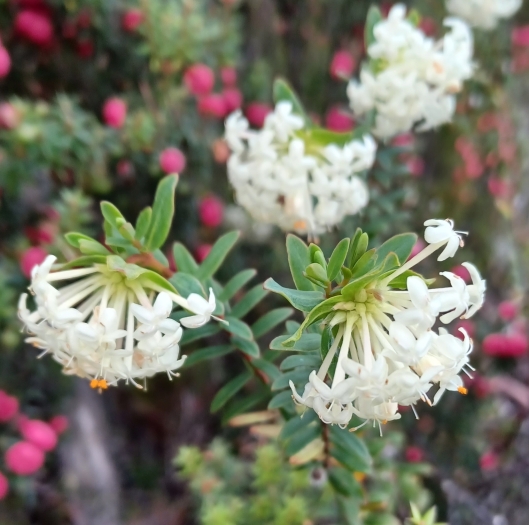Slender Rice Flower
(Pimelea linifolia)
Slender Rice Flower (Pimelea linifolia)
/
/

© Peter Crowcroft
CC BY 4.0
Image By:
© Peter Crowcroft
Recorded By:
Copyright:
CC BY 4.0
Copyright Notice:
Photo by: © Peter Crowcroft | License Type: CC BY 4.0 | License URL: http://creativecommons.org/licenses/by/4.0/ | Uploader: possumpete | Publisher: iNaturalist |












Estimated Native Range
Summary
Pimelea linifolia, commonly known as Slender Rice Flower, is a variable shrub native to a variety of habitats including dry sclerophyll forests, heathlands, and coastal dunes in eastern Australia, ranging from northeast Queensland to Tasmania. It typically grows up to 4 feet 11 inches high and features glabrous (smooth and hairless) stems with narrow, egg-shaped to elliptic leaves. The Slender Rice Flower is known for its delicate white to sometimes pink flowers, which are arranged in dense heads of up to 60 at the ends of the stems, each head surrounded by four lance-shaped bracts at the base. Flowering mainly occurs from late winter to early summer, and the blooms are modestly showy, attracting various pollinators.
The Slender Rice Flower is valued for its compact form and attractive floral displays, making it suitable for ornamental use in gardens, especially in native plantings and as a low hedge or border. It thrives in well-drained soils, tolerates a range of soil types from sandy to loamy, and prefers full sun to part shade conditions. While it is relatively low-maintenance, it benefits from pruning to encourage bushiness and prevent legginess. This species is not typically associated with aggressive roots or serious disease problems, but it can be susceptible to root rot in poorly drained soils. In cultivation outside its native range, care should be taken to prevent potential invasiveness.CC BY-SA 4.0
The Slender Rice Flower is valued for its compact form and attractive floral displays, making it suitable for ornamental use in gardens, especially in native plantings and as a low hedge or border. It thrives in well-drained soils, tolerates a range of soil types from sandy to loamy, and prefers full sun to part shade conditions. While it is relatively low-maintenance, it benefits from pruning to encourage bushiness and prevent legginess. This species is not typically associated with aggressive roots or serious disease problems, but it can be susceptible to root rot in poorly drained soils. In cultivation outside its native range, care should be taken to prevent potential invasiveness.CC BY-SA 4.0
Plant Description
- Plant Type: Shrub
- Height: 2-3 feet
- Width: 2-3 feet
- Growth Rate: Moderate
- Flower Color: White
- Flowering Season: Spring, Summer
- Leaf Retention: Evergreen
Growth Requirements
- Sun: Full Sun, Part Shade
- Water: Low
- Drainage: Medium, Fast
Common Uses
Border Plant, Drought Tolerant, Groundcover, Low Maintenance, Potted Plant, Rock Garden, Showy Flowers
Natural Habitat
Native to dry sclerophyll forests, heathlands, and coastal dunes in eastern Australia
Other Names
Common Names: Slender Rice Flower, Narrow-Leaf Pimelea, Queen-Of-The-Bush
Scientific Names: , Pimelea linifolia, Pimelea colorans, Pimelea mitchellae,
GBIF Accepted Name: